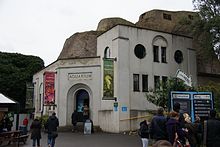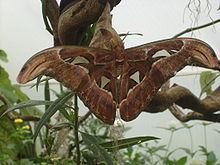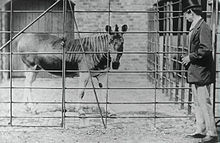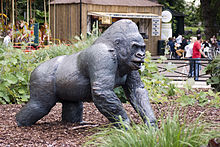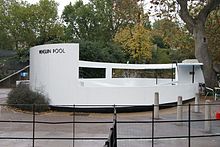
London Zoo
About this schools Wikipedia selection
This Wikipedia selection is available offline from SOS Children for distribution in the developing world. Visit the SOS Children website at http://www.soschildren.org/
 |
|
| Date opened | 1828 |
|---|---|
| Location | Regent's Park, London, England |
| Coordinates | 51°32′08″N 00°09′21″W Coordinates: 51°32′08″N 00°09′21″W |
| Land area | 36 acres (15 ha) |
| Number of animals | 17,519 (2012) |
| Number of species | 767 (2012) |
| Memberships | BIAZA, EAZA, WAZA |
| Major exhibits | Gorilla Kingdom, Animal Adventure, Blackburn Pavilion, Clore Rainforest Lookout, Into Africa |
| Website | ZSL London Zoo |
London Zoo is the world's oldest scientific zoo. It was opened in London on 27 April 1828, and was originally intended to be used as a collection for scientific study. It was eventually opened to the public in 1847. Today it houses a collection of 755 species of animals, with 16,802 individuals, making it one of the largest collections in the United Kingdom. The zoo is sometimes called Regent's Zoo.
It is managed under the aegis of the Zoological Society of London (established in 1826), and is situated at the northern edge of Regent's Park, on the boundary line between City of Westminster and Camden (the Regent's Canal runs through it). The Society also has a more spacious site at ZSL Whipsnade Zoo in Bedfordshire to which the larger animals such as elephants and rhinos have been moved. As well as being the first scientific zoo, ZSL London Zoo also opened the first Reptile house (1849), first public Aquarium (1853), first insect house (1881) and the first children's zoo (1938).
ZSL receives no state funding and relies on 'Fellows', 'Friends', 'Members', entrance fees and sponsorship to generate income.
History
ZSL was established by Sir Stamford Raffles and Sir Humphry Davy in 1826, who obtained the land for the Zoo and saw the plans before Raffles died of apoplexy (what would now be called a stroke) later that year on the 5th of July – his birthday. After his death the third Marquis of Lansdowne took over the project and supervised the building of the first animal houses. The Zoo opened in April 1828 to fellows of the Society, providing access to species such as Arabian oryx, greater kudus, orangutan and the now extinct quagga and thylacine. The Society was granted a Royal Charter in 1829 by King George IV, and in 1847 the Zoo opened to the public to aid funding.
It was believed that tropical animals could not survive outside in London's cold weather and so they were all kept indoors until 1902, when Dr Peter Chalmers Mitchell was appointed secretary of the Society. He set about a major reorganisation of the buildings and enclosures of the Zoo, bringing many of the animals out into the open, where many thrived. This was an idea inspired by Hamburg Zoo, and led to newer designs to many of the buildings. Mitchell also envisaged a new 600-acre (240 ha) park to the north of London, and in 1926 Hall Farm, near to Whipsnade village, was bought. In 1931 Whipsnade Wild Animal Park opened, becoming the world's first open zoological park. The first woman to be a curator at the London Zoo was Evelyn Cheesman.
In 1962, 'Caroline', an Arabian oryx, was lent to Phoenix Zoo, Arizona in the world's first international co-operative breeding programme. Today the Zoo participates in breeding programmes for over 130 species.
At the beginning of the 1990s, the Zoo had almost 7,000 animals; the nearest any other collection came to in Britain was Chester Zoo, with just under 3,500 animals. Many of the species in London Zoo could not be seen anywhere else in the country, such as the wombat, Tasmanian devil or long-nosed potoroo.
Although this vast collection was part of the Zoo's appeal, it may also have been one of the main causes of its financial problems. This contributed to the Zoo being faced with closure in the 1980s. Due to the public change of attitude to animals kept in captivity and unsuitably cramped space, the Zoo also suffered dwindling visitor numbers. However, when it was announced that London Zoo would close in 1991, a swell of public support in visitors and donations allowed the Zoo to continue its work, attempt to balance its books, and take on the huge task of restoring its buildings and creating environments more suitable for animal behaviour in the late 20th century.
One benefit of the 'swell of public support' was the development of volunteer staff. Employed by both Education and Animal care, these volunteers give one day a week to assist the running of London Zoo and can be recognised by their red sweaters.
Areas and attractions
| Group | Number of species | Number of individuals |
|---|---|---|
| Mammals | 74 | 500 |
| Birds | 118 | 641 |
| Reptiles | 66 | 279 |
| Amphibians | 26 | 175 |
| Fishes | 229 | 6398 |
| Invertebrates | 239 | 9750 |
| Total | 767 | 17519 |
Gorilla Kingdom
Opened by HRH Duke of Edinburgh in March 2007, Gorilla Kingdom is home to a group of western lowland gorillas, and consists of a large, moated island with an indoor gym for the gorillas to use. Currently, London Zoo owns three female gorillas named Zaire, Mjukku and Effie, and Gorilla Kingdom also features small enclosures housing Diana monkeys, black and white colobus, sooty mangabeys and white-cheeked gibbons.
Into Africa
Into Africa is an Africa-themed area that was opened in April 2006. Animals on display in this area include Chapman's zebras, warthogs, okapi, Rothschild's giraffes and African wild dogs. The giraffe enclosure features a high level viewing platform to give the public face-to-face contact with the giraffes, while the wild dog enclosure can only be observed through periscopes and observation decks.
Rainforest Life
A walk-through indoor rainforest exhibit that houses several different species of rainforest animals. Among the species in the main forest walk-through are two-toed sloths, golden-headed lion tamarins, sunbittern, red titi monkeys, emperor tamarins and trumpeter Birds. The building also has a darkened area called "Nightlife", which houses nocturnal animals such as Rodrigues fruit bats, slender lorises, armadillos and Malagasy giant rats.
The Aquarium
There has been an aquarium at the Zoo since 1853, the Zoo's first aquarium was also the world's first public aquarium. The word "aquarium" also originates at London Zoo, beforehand the term for a fish enclosure was "Aquatic Vivarium". The current aquarium was built in 1921 next the Mappin Terraces, and was officially opened by King George V and his wife Queen Mary in April 1924.
The aquarium is separated into three halls, each home to different types of fish and other aquatic wildlife. The first hall mostly contains freshwater species such as rudd and European eels, as well as species involved in various conservation projects and captive-breeding programmes, such as broad sea fans, seahorses and spiny starfish. The second hall has a coral reef theme, and houses various species of reef fish from around the world, such as clownfish, copperband butterflyfish and regal tangs, as well as real coral. The third hall houses species native to the Amazon River, including red-bellied piranhas, electric eels and ocellate river stingrays. As well as the three halls, the aquarium also features the "Big Fish Tank", which contains large fish species that are all former pets, and had to be rescued because their owners did not have the proper equipment or understanding to look after them. The species in the Big Fish Tank include tambaqui, catfish and pirapitinga.
Mappin Terraces/The Outback
An enclosure that opened to the public in 1913, and features an artificial rocky cliff made of concrete for animal enrichment. Currently, the Mappin Terraces houses groups of red-necked wallabies and emu in an Australia-themed exhibit called "The Outback".
Animal Adventure
An area aimed primarily at children, featuring playgrounds and a water fountain. Many of the animals in Animal Adventure are domestic livestock, such as sheep, llamas, alpacas, donkeys and kunekune pigs. Other animals on display in this area include yellow mongooses, crested porcupines, aardvarks, ring-tailed coatis and one of the zoo's two groups of meerkats (the other group live in an enclosure next to the Rainforest Life building). The meerkat enclosure features a tunnel that small children can crawl through until they reach a see-through dome that allows them to see directly into the enclosure.
The Reptile House
One of London Zoo's most well-known buildings (even before it featured in Harry Potter and the Philosopher's Stone, in a scene in which the young Harry accidentally releases a python), the Reptile House opened in 1927 and was designed by Joan Beauchamp Procter and Sir Edward Guy Dawber. It houses several different species of reptile, including Jamaican boa, Philippine crocodiles, eastern diamondback rattlesnakes, black mambas, rhinoceros iguanas, king cobras, Philippine sailfin lizards and veiled chameleons. In December 2012, a refurbished amphibian section was opened to the public, displaying amphibians such as African bullfrogs, mountain chickens, waxy monkey frogs and various types of poison dart frog, as well as caecillians and mudskippers.
Giants of the Galapagos
Giants of the Galapagos was opened in 2009 and is home to five Galápagos giant tortoises, a male named Dirk and four females named Dolly, Dolores, Polly and Priscilla. The exhibit features a large indoor area, with a heated pond and underfloor heating, while the outdoor paddock has been designed to mimic the tortoise's natural environment and features two heated pools, one of which is a naturalistic clay wallow.
Komodo Dragons
London Zoo's Komodo dragon enclosure was opened by Sir David Attenborough in July 2004. Currently, the zoo houses two Komodo dragons, a female named Rinka and a male named Raja. Their enclosure is designed to resemble a dry river bed, the dragon's natural habitat, and sounds of Indonesian birds are regularly played into the enclosure.
Tiger Territory
A new, updated enclosure for the Zoo's Sumatran tigers, which opened to the public in Spring 2013. The zoo currently owns two tigers, a male named Jae Jae and a female named Melati, both of whom arrived at the zoo in October 2012, from Akron Zoo in Ohio and Perth Zoo in Australia respectively. Tiger Territory is 2,500 square metres (27,000 square feet) in size, and features authentic Indonesian plant life. The new enclosure, which cost £3.6 million, was designed by Michael Kozdon, and features a canopy of 3mm steel cable.
B.U.G.S
B.U.G.S (which stands for Biodiversity Underpinning Global Survival) is held in a building called The Millennium Conservation Centre, and aims to educate the public about biodiversity. The building displays over 140 species, the majority of which are invertebrates. Among the animals kept in B.U.G.S. are praying mantises, leafcutter ants, moon Jellyfish, golden mantella frogs, Mexican red-knee tarantulas, naked mole rats, brine shrimp, Bali starlings, Jungle nymphs and giant orb spiders. The Millennium Conservation Centre aims to be environmentally friendly, constructed from materials requiring little energy to produce, and generating its heating from the body heat of both the animals and visitors.
Penguin Beach
Penguin Beach opened in 2011 and houses around sixty penguins of three different species: African penguins, Humboldt penguins and a single, male rockhopper penguin named Ricky. The pool itself is currently the largest penguin pool in an English zoo.
Meet The Monkeys
Opened by comedians Noel Fielding and Julian Barratt in 2005, Meet the Monkeys is a walk-through enclosure that houses a troop of squirrel monkeys. The exhibit has no roof, and there are no boundaries between the monkeys and the visitors.
Butterfly Paradise
Opened in May 2006, Butterfly Paradise houses several different species of butterfly and moth from around the world, as well as plant species specially selected to provide nectar and breeding areas for the insects. Species on display in the exhibit include the clipper butterfly, great eggfly butterfly, atlas moth, zebra longwing and postman butterfly. The exhibit also features a caterpillar hatchery and a cocoon display cabinet, where visitors can witness different types of pupae and the development of new butterflies.
African Bird Safari
The African Bird Safari opened in 2005 as a redevelopment of the old stork and ostrich house, replacing three enclosures that were out of date by modern zoo-keeping standards. It is a walk-through exhibit housing various species of African birds including superb starlings, Von der Decken's hornbills, Bernier's teals, Abdim's storks, blue-bellied rollers and lilac-breasted rollers.
The Snowdon Aviary
The Snowdon Aviary was designed by Cedric Price, Frank Newby and Antony Armstrong-Jones, 1st Earl of Snowdon, and was built in 1964. Over the years a variety of birds have been kept in the aviary from birds of prey to waterfowl, and it currently houses green peafowl, sacred ibis, little egrets, cattle egrets, northern bald ibis and grey-headed gulls.
Blackburn Pavilion
The Blackburn Pavilion is a rainforest-themed tropical bird aviary that opened in March 2008, as a refurishment of the zoo's out-of-date bird house. The building was originally built in 1883, as a reptile house. The pavilion houses fifty different species of exotic birds, including Socorro doves, amazilia hummingbirds, Mindanao bleeding-hearts, Bali starlings, toco toucans, splendid sunbirds, Victoria crowned pigeons and blue-winged kookaburras. One of the pavilion's prominent features is a large, elaborate clock outside the main entrance, which gives a bird-themed display every thirty minutes throughout the day.
Others
Other notable animals in London Zoo's collection include Asian lions, black vultures, greater flamingos, servals, pygmy hippopotamus, ring-tailed lemurs, Bactrian camels, red-faced spider monkeys, king vultures, Asian small-clawed otters, reindeer, giant anteaters, Rüppell's griffin vultures, Bornean bearded pigs and great white pelicans.
Future developments
In February 2011, ZSL London Zoo launched its new Tiger S.O.S programme in which it is hoped to raise funds to help save the Sumatran Tiger. The zoo will not only use these funds in extending its three signature projects in Indonesia but build a new Tiger Conservation HQ at the zoo, plus a new exhibit where the tigers can be seen.
The new development is part of the new master plan to create better accessibility, which involves relocating the main entrance to the east, adjacent to the Broad Walk in Regent's Park.
Notable animals
Throughout its history the Zoo has had many well-known residents. These may have been scientifically important individuals or simply beloved by the public.
The Zoo was home to the only living quagga ever to be photographed, before the species became extinct in the wild due to hunting in southern Africa in about 1870. Another now extinct species the Zoo held was a number of thylacines, or marsupial wolves.
The first hippopotamus to be seen in Europe since the Roman Empire, and the first in England since prehistoric times, arrived at London Zoo in May 1850 as a gift from the Ottoman Viceroy of Egypt in exchange for some greyhounds and deerhounds. The hippo was named Obaysch and led to a doubling of the Zoo's visitors that year.
In 1865, Jumbo, the largest elephant known at the time, was transferred to the Zoo from Jardin des Plantes in Paris. His name, possibly from Jambo, Swahili for hello, became an epithet for anything of large size, such as Boeing's 747 Jumbo jet. He became aggressive in old age, and had to stop giving rides; he was sold to Phineas Barnum's circus, the Barnum & Bailey Circus, in 1882, where he was later crushed by a locomotive and killed.
Winnipeg bear (or Winnie) was an American black bear given to the Zoo in 1914 by a Canadian Lieutenant, Harry Colebourn. A. A. Milne visited with his son Christopher Robin, and the boy was so enamoured with the bear Milne wrote the famous series of books for him entitled Winnie-the-Pooh. A 2004 film A Bear Named Winnie is based on the story of Winnie the bear, with Michael Fassbender playing Harry Colebourn.
Guy, a western lowland gorilla, arrived at the Zoo on Guy Fawkes Night (hence the name) 1947 from Paris Zoo, and lived at the Zoo until his death in 1978. Over his 32-year life he became one of the Zoo's best-loved residents. After years of trying to find a mate, in 1969 five-year-old Lomie arrived from Chessington Zoo. They were kept separated for a year to adjust to each other, until they were finally united. Although they got on well together they never produced any offspring. In 1982 Guy was commemorated by a bronze statue, sculptured by William Timyn.
On 27 November 1949 Brumas became the first polar bear to be successfully bred at the Zoo, and immediately became a major attraction with the public. This led to the Zoo's annual attendance to rise to over 3 million in 1950 - a figure that has yet to be topped. Although a female, the press reported that she was a 'he' and this was not corrected at the time, leading the public to believe the bear was a male. Eighteen years later, on 1 December 1967 the second polar bear bred at the Zoo, this time a male, was born. He was named Pipaluk ( Inuit for little one) but, in 1985, had to leave the Zoo when the Mappin Terraces closed.
The Zoo's first giant panda, Chi Chi, arrived in 1958. Although originally destined for an American zoo, Washington had ceased all trade with communist China and so Chi Chi was refused entry to the United States. In the interests of conservation, ZSL had stated they would not encourage the collection of wild pandas. However, when it was pointed out that Chi Chi had already been collected, her purchase was approved, and she immediately become the star attraction at London Zoo. As the only giant panda in the west she was the inspiration of Peter Scott's design for the World Wildlife Fund logo. In July 1972, Chi Chi died and was publicly mourned. The Zoo's last giant panda was Ming Ming. She arrived in 1991 on a breeding loan from China. After unsuccessful breeding attempts with Berlin's Zoo giant panda Bao Bao it had been decided to return Ming Ming to China, leaving the London Zoo without a giant panda since the end of October 1994.
For four days in late August 2005, the Zoo ran an exhibit entitled the Human Zoo, which put eight humans on display in the Mappin Terraces. The idea behind the exhibit was to demonstrate the basic nature of man as an animal and examine the impact we have on the animal kingdom.
Today the Zoo holds the only population of humming birds in the United Kingdom in the Blackburn Pavilion.
Architecture
Since its earliest days, the zoo has prided itself on appointing leading architects to design its buildings, today it holds two Grade I, and eight Grade II listed structures.
The initial grounds were laid out in 1828 by Decimus Burton, the Zoo's first official architect from 1826 to 1841, made famous for his work on the London Colosseum and Marble Arch. Burton's work began with the Clock Tower in 1828 above what was then the llama house, which today is the first aid kiosk. In 1830 the East Tunnel, which linked the north and south parts of the zoo together for the first time, was completed, which also acted as a bomb shelter during World War II. Burton concluded his work in 1837 with the Giraffe House, which, due to its functional design, still remains in use as the Zoo's giraffe enclosure in the Into Africa exhibit.
After Burton, Sir Peter Chalmers Mitchell and John James Joass were appointed to design the Mappin Terraces. Completed in 1914, the Mappin Terraces imitates a mountain landscape to provide a naturalistic habitat for bears and other mountain wildlife. In 1933 the Round House, designed by Berthold Lubetkin's Tecton Architectural Group to house gorillas, was one of the first modernist style buildings to be built in Britain. The following year the Penguin Pool, also designed by Tecton, was opened; both are now grade I listed. The Modernist dual concrete spiral ramps of the Penguin Pool have made it famous, but during a 2004 refurbishment the penguins took a strong liking to the duck pond they had been temporarily relocated to, and they were moved out of the Penguin Pool permanently.
The Snowdon Aviary, built in 1964 by Cedric Price, Lord Snowdon and Frank Newby, made pioneering use of aluminium and tension for support. A year later the Casson Pavilion, designed by Sir Hugh Casson and Neville Conder, was opened as an elephant and rhinoceros house. The Pavilion was commissioned "to display these massive animals in the most dramatic way" and designed to evoke a herd of elephants gathered around a watering hole.
In Film and Television
Many films and television programmes have made use of London Zoo as a film set.
In 1947, Carol Reed took his film crew and actors Ralph Richardson; Michèle Morgan and Bobby Henrey to London Zoo to film location scenes there for The Fallen Idol (released in 1948). Scenes were filmed inside the lion house and the reptile house and on the Mappin Terraces. Today, the scenes give an historic view of what the zoo looked like in the immediate post war years.
In 2000, the Burmese python scene from the 2001 film Harry Potter and the Philosopher's Stone was filmed at the Zoo's Reptile House. In the film the inhabitant of the tank is a Burmese python, however in reality it is home to a black mamba. A plaque beside the enclosure commemorates the event.
A couple of scenes were filmed here for the ITV series Primeval. The first was a confrontation between Helen Cutter and Claudia Brown in the old elephant house. The second was a brief scene that showed Abby Maitland with a Komodo Dragon. Although the fictional Wellington Zoo played a large role in the episode, most scenes were filmed at Whipsnade Zoo.
In the "Exploitin" episode of the fifth series of Absolutely Fabulous, Edina and Patsy steal Saffy's new-born infant for a Jean-Paul Gaultier fashion shoot at the Zoo.
In the final scene from the 1987 film Withnail and I a sad Withnail is shown standing in the pouring rain next to the former wolf enclosure, declaiming the speech What a piece of work is a man from Hamlet.
Part of the 1985 film Turtle Diary, based on the novel by Russell Hoban and starring Ben Kingsley and Glenda Jackson, was also filmed here; the film follows a plan to help two of the turtles escape from the Zoo.
The music video for the Talk Talk song " It's My Life" was filmed at London Zoo in 1984. The video was used as a statement against the banality of lip-syncing and includes mostly footage from nature documentaries with shots of lead singer Mark Hollis in the Zoo keeping his mouth shut, obscured by hand-drawn animated lines.
During the 1981 film An American Werewolf in London, the lead character David Kessler (played by David Naughton) woke up naked in the wolves' enclosure. Several other animals are also seen and you can clearly see the old caged enclosures of the tigers and apes.
A scene from the 1964 film The Pumpkin Eater with Anne Bancroft and James Mason was also set at the Zoo.
Duran Duran filmed parts of the music video for their 1993 hit Come Undone at the London Zoo Aquarium section.
Transport Connections
There are multiple transport connections to London Zoo




